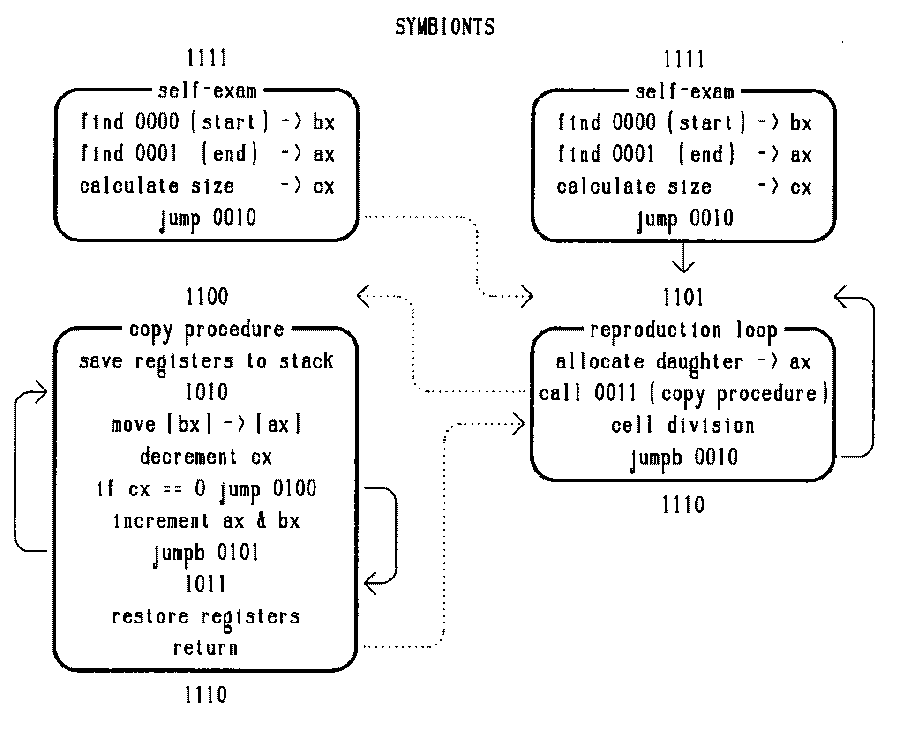
The only communities whose ecology has been explored in detail are those that operate under selection for small sizes. These communities generally include a large number of parasites, which do not have functional copy procedures, and which execute the copy procedures of other creatures within the search limit. In exploring ecological interactions, the mutation rate is set at zero, which effectively throws the simulation into ecological time by stopping evolution. When parasites are present, it is also necessary to stipulate that creatures must breed true, since parasites have a tendency to scramble genomes, leading to evolution in the absence of mutation.
0045aaa is a ``metabolic parasite''. Its genome does not include the copy procedure, however it executes the copy procedure code of a normal host, such as the ancestor. In an environment favoring small creatures, 0045aaa has a competitive advantage over the ancestor, however, the relationship is density dependent. When the hosts become scarce, most of the parasites are not within the search limit of a copy procedure, and are not able to reproduce. Their calls to the copy procedure fail and generate errors, causing them to rise to the top of the reaper queue and die. When the parasites die off, the host population rebounds. Hosts and parasites cultured together demonstrate Lotka-Volterra population cycling ([25,35,36]).
A number of experiments have been conducted to explore the factors affecting diversity of size classes in these communities. Competitive exclusion trials were conducted with a series of self-replicating (non-parasitic) genotypes of different size classes. The experimental soups were initially inoculated with one individual of each size. A genotype of size 79 was tested against a genotype of size 80, and then against successively larger size classes. The interactions were observed by plotting the population of the size 79 class on the x axis, and the population of the other size class on the y axis. Sizes 79 and 80 were found to be competitively matched such that neither was eliminated from the soup. They quickly entered a stable cycle, which exactly repeated a small orbit. The same general pattern was found in the interaction between sizes 79 and 81.
When size 79 was tested against size 82, they initially entered a stable cycle, but after about 4 million instructions they shook out of stability and the trajectory became chaotic with an attractor that was symmetric about the diagonal (neither size showed any advantage). This pattern was repeated for the next several size classes, until size 90, where a marked asymmetry of the chaotic attractor was evident, favoring size 79. The run of size 79 against size 93 showed a brief stable period of about a million instructions, which then moved to a chaotic phase without an attractor, which spiraled slowly down until size 93 became extinct, after an elapsed time of about 6 million instructions.
An interesting exception to this pattern was the interaction between size 79 and size 89. Size 89 is considered to be a ``metabolic cripple'', because although it is capable of self-replicating, it executes about 40% more instructions than normal to replicate. It was eliminated in competition with size 79, with no loops in the trajectory, after an elapsed time of under one million instructions.
In an experiment to determine the effects of the presence of parasites on community diversity, a community consisting of twenty size classes of hosts was created and allowed to run for 30 million instructions, at which time only the eight smallest size classes remained. The same community was then regenerated, but a single genotype (0045aaa) of parasite was also introduced. After 30 million instructions, 16 size classes remained, including the parasite. This seems to be an example of a ``keystone'' parasite effect ([28]).
Symbiotic relationships are also possible. The ancestor was manually dissected
into two creatures, one of size 46 which contained only the code for
self-examination and the copy loop, and one of size 64 which contained only
the code for self-examination and the copy procedure (Figure 3). Neither
could replicate when cultured alone, but when cultured together, they both
replicated, forming a stable mutualistic relationship. It is not known if
such relationships have evolved spontaneously.
